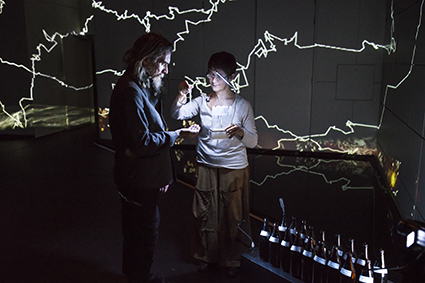 |
Igneous performance: James Cunningham and Suzon Fuks photo Alan Warren |
This is very considered and deliberate art-making and you feel that sense of solemnity and purpose in the installation. Walking into the black vaulted expanse of The Block you are first struck by a projection which cuts through the space at a 180-degree angle from ceiling to floor and then up the entire length of the opposite wall. It is an impossible river of scrolling encryptions, data recorded by Fuks and Cunningham as they traversed the 663 waterways, drove the 7,500km and walked the two dozen creeks that make up the entire footprint of this enormous project in Central Western Queensland.
You turn a corner and meet curving black flats and a small nook, which invites you to listen to a guided meditation. This entreaty to “slow down, to meander” is an essential part of the installation. Fuks and Cunningham clearly feel such a strong custodianship of the rivers they walked through so slowly and so carefully that they cannot bear the thought that you do not get to experience the sense of durational spirituality that they did.
This is reinforced by curator Rachel Parson, whose thoughtful and considered curatorial essay frames the journey of Fuks and Cunningham in the tradition of “the groundbreaking experimental soundwork of John Cage in the 1950s and 1960s.” She suggests that the artists’ slow and intricate walking “becomes a symbolic gesture, a way to absorb the memories, movements and scars of the landscape…that leaves no lasting trace, becoming another memory within the historical and ongoing shaping of the land by environmental and historical forces.”
There is a sound installation based on the nature of walking and balance in the larger dramatic space of the main exhibition which is dominated by the projected map of Fuks and Cunningham’s travels, a kind of twiggy, arching artery across the back wall. Beneath it, Cunningham performs live an ultra slow and stately walk. In the immediate foreground a wall of video monitors lights up on touch, offering elongated vistas of creeks. On the other side of the installation is a collection of tiny bottles with water from each of the creeks walked: Ross River, Coppermine, Cloncurry, Condomine, Emerald, Miles, Blackwater and Nettle Creeks. And there’s a small bed of sand with discarded objects collected along the way.
Parsons ends her essay by urging patrons to accept the strong invitation of the work to “take time…find a resonance between the body and the various technologies…to experience depth and details…to commit to the meander.”
 |
Igneous performance photo Alan Warren |
In the large square room, with its stations reminiscent of a regional museum display, a series of low-set black boxes curved a gentle path through the centre of the installation. Although square, these boxes felt like bird baths, or scrying bowls that glowed with light and sound. Some contained recordings of interviews with local farmers, councillors and other folks met along the way. I had no urge to actually listen to the stories, but I so enjoyed hearing snatches of their voices as I walked past.
Other bowls had iPads nestled inside, flashing close-up images of more tiny details of landscape like knots of wood that looked like horses’ heads. These smaller installations invited an embodied participation, a leaning in and sitting patiently; watching the tiny beauty of an unfamiliar landscape and engaging with it tipped me into a kind of reverie. I left the installation feeling as though I had received a massage. I suppose, to quote Suzon Fuks and James Cunningham, I had experienced what they wanted me to: deep time.
Read the interview with the FLUIDATA artists in RealTime Profiler 10.
FLUIDATA: an explorable installation by Igneous, QUT Digital Associates Program, The Block, QUT, Brisbane, 13-20 June
RealTime issue #128 Aug-Sept 2015 pg. 23
© Kathryn Kelly; for permission to reproduce apply to [email protected]








 back
back